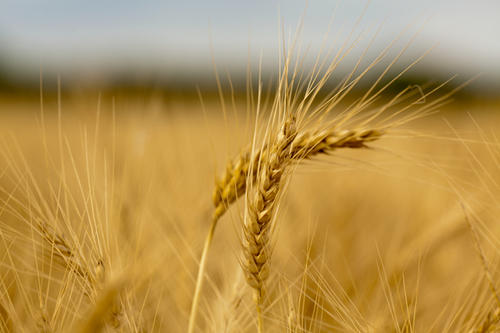
Minnesota is on track to break its wheat harvest record and, for the first time in nearly 30 years, the number of acres planted with University of Minnesota-developed varieties edged over the 50 percent mark.
Harvest is tracking at a record-breaking 67 bushels, shattering the previous record of 60 bushels per acre set in 2015, said University of Minnesota Extension small grains scientist Jochum Wiersma. Yield trends from 1995 to 2016 have shown an overall 2.7 percent increase in average yield per year.
“We’re pleased with the performance of the newer varieties released by the University, including Linkert and Shelly,” Wiersma said. The Linkert variety was released by the University in 2013; Shelly became available last year. In 2017, 50.6 percent of wheat planted in Minnesota was developed at the University. “Linkert was planted on half a million acres and it has particularly good straw strength, while Shelly is coming in with impressive yields.”
About 1.17 million acres of Minnesota farmland were planted with wheat in 2017, down from 1.3 million last year. Market volatility over the last two decades has kept wheat acreage from expanding significantly beyond its strongholds in northwestern Minnesota, where about 80 percent of the state’s crop is grown.
Nonetheless, wheat is making some inroads in southern Minnesota. Farmers recognize wheat’s value, including the benefits of planting it as a rotation crop to break disease and pest cycles, Wiersma said. Wheat uses less water, for instance, compared to full-season crops like soybeans and corn, allowing the soil to recharge for the next season.
“Growers are selecting among the 40 or so available varieties based primarily on their yield, protein content, resistance to lodging, and disease resistance,” said Jim Anderson, professor and wheat breeder in the University’s Department of Agronomy and Plant Genetics. Anderson and Wiersma work closely on variety selection for the trials. Anderson added “not only did Minnesota wheat growers shatter the state’s record yields, but they did so growing high-quality varieties that will be valued on the national and international markets.”
Anderson, Wiersma and University colleagues study the strengths and weaknesses of new wheat varieties at more than 5,000 yield plots per year, seeking the best candidates for release. It currently takes eight to 10 years to get a new variety to market, though new varieties are cycling through more quickly. The breeding program expanded the number of testing locations and variety candidates evaluated beginning in 2010.
Initial trials take place on the U’s St. Paul, Crookston and Morris campuses, before expanding to include many private farms where growers collaborate with researchers. More about Extension’s small grains program is available at https://www.extension.umn.edu/agriculture/small-grains/.
----
For more news from U of M Extension, visit www.extension.umn.edu/news or contact Extension Communications at [email protected]. University of Minnesota Extension is an equal opportunity educator and employer.
- Categories:
- Agriculture and Environment





